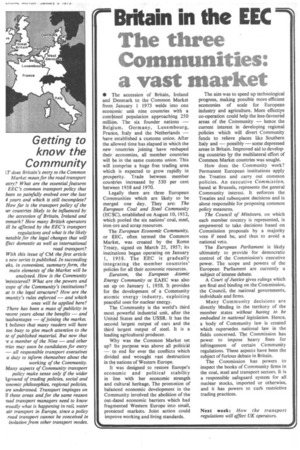Britain in the EEC The three Comm ities.
Page 33

If you've noticed an error in this article please click here to report it so we can fix it.
a vast market
• The accession of Britain, Ireland and Denmark to the Common Market from January 1 1973 welds into one economic unit nine countries with a combined population approaching 250 million. The six founder nations — Belgium, Germany, Luxembourg, France, Italy and the Netherlands — have established a customs union. After the allowed time has elapsed in which the new ; countries joining have reshaped their, economies, all member countries will he in the same customs union. This will comprise a huge free trading area which is expected to grow rapidly in prosperity. Trade between member countries increased by 530 per cent between 1958 and 1970.
Legally there are three European Communities which are likely to be merged one day. They are: The European Coal and Steel Community (EC SC), established on August 10, 1952, which pooled the six nations' coal, steel, iron-ore and scrap resources.
The European Economic Community, or EEC, often termed the Common Market, was created by the Rome Treaty, signed on March 25, 1957; its institutions began operating on January 1, 1958. The EEC is gradually integrating the member countries' policies for all their economic resources.
Euratom, the European Atomic Energy Community or EAEC was also set up on January 1, 1958. It provides for the development of a Community atomic energy industry, exploiting peaceful uses for nuclear energy.
The Community is the world's third most powerful industrial unit, after the United States and the USSR. It has the second largest output of cars and the third largest output of steel. It is a leading agricultural producer.
Why was the Common Market set up? Its purpose was above all political — to end for ever the conflicts which divided and wrought vast destruction in the nations of Western Europe.
It was designed to restore Europe's economic and political stability in line with her economic strength and cultural heritage. The promotion of balanced economic development in the Community involved the abolition of the out-dated economic barriers which had fragmented Western Europe into small, protected markets. Joint action could improve working and living standards. The aim was to speed up technological progress, making possible more efficient economies of scale for European industry and agriculture. More effectiye co-operation could help the less-favoured areas of the Community — hence the current interest in developing regional policies which will divert Community funds to relieve places like Southern Italy and — possibly — some depressed areas in Britain. Improved aid to developing countries by the multilateral effort of Common Market countries was sought.
How does the Community work? Permanent European institutions apply the Treaties and carry out common policies. An executive Commission, based at Brussels, represents the general Community interest. It enforces the Treaties and subsequent decisions and is alone responsible for proposing common policy measures.
The Council of Ministers, on which each member country is represented, is empowered to take decisions based on Commission proposals by a majority vote if need be, and thus to avoid a national veto.
The European Parliament is likely ultimately to provide for democratic control of the Commission's executive power. The scope and powers of the European Parliament are currently a subject of intense debate.
A Court of Justice gives rulings which are final and binding on the Commission, the Council, the national governments, individuals and firms.
Many Community decisions are directly binding in the territory of the member states without having to be embodied in national legislation. Hence, a body of Community law is created which supersedes national law in the fields concerned. The Commission has power to impose heavy fines for infringement of certain Community regulations. These aspects have been the subject of furious debate in Britain.
The Commission has powers to inspect the books of Community firms in the coal, steel and transport sectors. It is a responsible safeguard system for all nuclear stocks, imported or otherwise, and it has powers to curb restrictive trading practices.




























































































